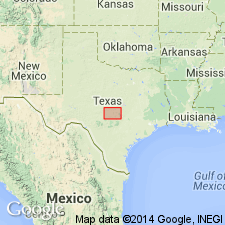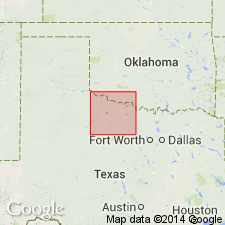
- Usage in publication:
-
- Placid shale [member]
- Modifications:
-
- Named
- Dominant lithology:
-
- Shale
- Sandstone
- Clay
- Limestone
- AAPG geologic province:
-
- Bend arch
- Llano uplift
Summary:
Named for town of Placid, McCulloch Co, TX on Llano uplift; town is situated on the outcrop. No type locality designated. Was called "Bed No. 7" by Drake (1893); here called Placid shale [member], second from top of four [members] of Brad formation of Canyon group (both revised) in Colorado River Valley area. In Colorado River Valley area Brad formation consists of (ascending): Cedarton shale, Clear Creek limestone, Placid shale, and Ranger limestone [members]. In the Brazos River Valley (to north) Brad formation consists of (ascending): Seaman Ranch beds [also called member], and Ranger limestone [member]. The Placid is shale containing in places lentils of sandstone. This member makes up the lower part of the escarpment which is capped by the Ranger limestone [member], and in many places excellent exposures are found. Authors quote Drake's original lithologic description: "West of Lookout Mountain the bed consists of from 40 to 50 feet of clay parted near the middle by two or three feet of dark-colored limestone, which in some places is overlain by a thin stratum of sandstone...The bed increases in thickness to the north for ten or fifteen miles. Southwest of Brownwood it is from 30 to 50 feet thick, and the clay is sandy, reddish to purple in color, and capped by from five to six feet of conglomeratic sandstone." Is Pennsylvanian in age. Measured section. Correlation chart.
Source: GNU records (USGS DDS-6; Denver GNULEX).

- Usage in publication:
-
- Placid shale member
- Modifications:
-
- Not used
Summary:
Placid shale member of Brad formation of Canyon group--as defined by Plummer and Moore, [1922]--not used in this report. Report area is the Colorado River Valley, Coleman and Brown Cos, TX on Bend arch. Brad formation revised--restricted to include Ranger limestone member at top, and an unnamed shale member (including the cherty limestone of Drake, 1893), at base. The newly named Winchell member of underlying Graford formation (revised)--which includes the Clear Creek Bed of Drake, 1893, and the lower, limestone-bearing part of the Placid shale member of Brad formation of Plummer and Moore, [1922]--is here assigned to Graford formation; this restricts the Brad formation to the Ranger limestone member and the upper, unnamed shale portion of Plummer and Moore's Placid shale member (term Placid not used). Generalized columnar section. Measured section. Pennsylvanian age.
Source: GNU records (USGS DDS-6; Denver GNULEX).

- Usage in publication:
-
- Placid shale
- Modifications:
-
- Revised
- AAPG geologic province:
-
- Bend arch
Summary:
Placid revised--removed as a member of Brad formation and rank raised to formational status. Name Brad formation, as defined by the USGS in 1960--with Placid shale member (at base), and Ranger limestone member (at top)--not used. Placid shale and Ranger limestone used as formations in this report. Area of report is the Colorado River Valley area, Brown Co, TX on Bend arch. Placid shale overlies Winchell limestone; underlies Ranger limestone. Stratigraphic chart. Of Canyon [Pennsylvanian] age. [Author does not capitalize rank terms; however, units are considered to be formal.]
Source: GNU records (USGS DDS-6; Denver GNULEX).

- Usage in publication:
-
- Placid Shale
- Modifications:
-
- Areal extent
- AAPG geologic province:
-
- Bend arch
- Fort Worth syncline
Summary:
Mapped as a formation of Canyon Group in the southeastern part of the mapped area, north-central TX (ascending): Palo Pinto Formation, Wolf Mountain Shale, Winchell Limestone, Placid Shale, Ranger Limestone, Colony Creek Shale, and Home Creek Limestone. Farther east, Canyon is divided into (ascending): Willow Point Formation, Jasper Creek Formation and its Chico Ridge Limestone [unranked], Ventioner Formation, Ranger Limestone, and Colony Creek Shale. Placid and Winchell are partially equivalent to part of Ventioner Formation, to east. Placid is mostly shale, gray, weathers to tan, locally sandy and calcareous, ferruginous nodules are variably abundant throughout, locally very fossiliferous in upper part; sandstone in lentils and sheets 1-8 ft thick, fine to medium grained, calcareous, thin bedded, cross bedded, ripple marked, sparsely fossiliferous; limestone lentil 1-2 ft thick in upper part. Placid is 110-130 ft thick; thickens northeastward. Unnamed sandstones, separately mapped, are equivalent to sandstones of Ventioner. Age is Missourian (Late Pennsylvanian). Geologic map.
Source: GNU records (USGS DDS-6; Denver GNULEX).
For more information, please contact Nancy Stamm, Geologic Names Committee Secretary.
Asterisk (*) indicates published by U.S. Geological Survey authors.
"No current usage" (†) implies that a name has been abandoned or has fallen into disuse. Former usage and, if known, replacement name given in parentheses ( ).
Slash (/) indicates name conflicts with nomenclatural guidelines (CSN, 1933; ACSN, 1961, 1970; NACSN, 1983, 2005, 2021). May be explained within brackets ([ ]).

